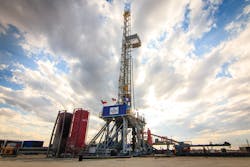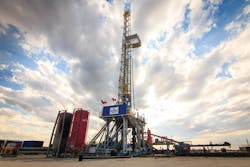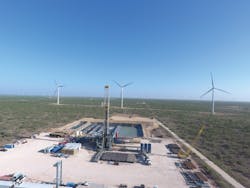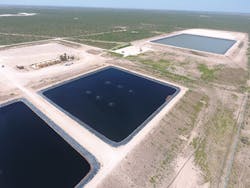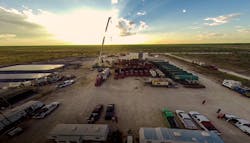Laredo Petroleum manages Big Data
COMPANY UTILIZES ADVANCED TECHNOLOGIES, WORKFLOWS, EXTENSIVE DATABASES IN DRILLING PROGRAM
ANTHONY ANDORA, EDGE CONSULTING, SANTA MONICA, CALIF.
Think of the largest oil producing regions in the world. Did you think Saudi Arabia, Iran, or Russia? What about Texas? Was Texas included in your list of top oil producing regions in the world? Many people may not know this but if Texas were its own country it would rank as roughly the fifth-largest oil-producing region in the world. And if we take that one step further and look solely at the Permian Basin and consider the Permian Basin as its own country, it would rank as roughly the twelfth-largest oil-producing region in world.
But unlike days past, when Texas wildcatters would forge out into the world with the hopes of finding oil and natural gas on a wing and a prayer, today's companies are using new technologies, technical workflows, extensive databases and planning methodologies to all but ensure their success before drilling a multi-million-dollar well.
Laredo Petroleum, a pure-play Permian Basin oil producer, is using data gathered since the inception of the company, along with advanced technical workflows to guide the planning of its drilling program and success. This approach toward developing its multi-decade inventory enhances the overall value of its acreage and, equally important, limits the risk profile for its shareholders.
PREVIOUS SUCCESS DRIVES ADDED VALUE
Randy A. Foutch has made a career out of finding and developing oil properties in some of the industry's most successful basins. One of his first major stretches as CEO of an oil and natural gas company was with Lariat Petroleum, an E&P company with assets located predominantly in the Anadarko Basin. Founded in 1996, Foutch invested roughly five years, identifying, developing, and building the company's asset base before Newfield Exploration came knocking on Lariat's door and acquired the company in 2001 at a premium valuation.
Too young to retire, Foutch wasted no time before embarking on his next endeavor. He founded Latigo Petroleum in 2002, only a few short months after the sale of Lariat to Newfield. And though Latigo started out as a mid-continent player, it wasn't long before Foutch decided to enter the Permian Basin with an acquisition that would become the backbone of Latigo's asset base.
The acquisition added approximately 42,000 gross acres in Reeves and Ward counties and interests in 500 producing wells. Before long, Latigo had an asset base of more than 405,000 net acres, a deep inventory of over 400 identified drilling locations, and a working interest of more than 70%. This time however, it wasn't Newfield Exploration that came knocking at Latigo's door but Pogo Producing Company. Attracted to Latigo's deep inventory of identified prospects and contiguous acreage position, Pogo Producing acquired Latigo in April 2006, again at a premium valuation.
Today, Foutch is busy executing his largest Permian Basin effort to date as founder, chairman, and CEO of Laredo Petroleum, a pure-play Permian Basin producer. But unlike his previous endeavors, which involved conventional development, Laredo Petroleum is focused on unconventional development with the implementation of horizontal drilling applications.
Unconventional development, however, is not inexpensive. In parts of the basin, well costs average between $4 million to more than $7 million per well. To increase the chances of success, Foutch and his team are deploying a range of tactics and strategies such as the company's data-driven Earth Model database and robust infrastructure with enhanced production corridors to achieve optimum efficiencies.
DATABASE DESIGNED TO BUILD MULTI-DECADE INVENTORIES
While the Earth Model database may not be as well recognized as applications such as horizontal drilling or fracture stimulation, Foutch's companies have been developing and utilizing versions of it for more than 25 years. His companies have used it in conventional development and in different basins. On more than one occasion, a predecessor to today's data-driven Earth Model was used to drive increased efficiencies and build a high-graded inventory of identified drilling prospects in conventional targets. So what's different about today's version compared to the version that Foutch used with his previous companies? Big Data.
Laredo's Earth Model applies the same investment philosophy in acquiring data as with the above-ground development in infrastructure, "to begin with the end in mind." Laredo has collected comprehensive subsurface technical data sets across its acreage position, including 3D seismic, microseismic, cores, wireline logs, fluid properties, reservoir and natural fracturing data along with additional necessary information. Proprietary workflows calibrate single-point measurements of reservoir and mechanical rock properties from vertical cores and expand into three dimensions using inversions from 3D seismic data to provide the best possible representations of subsurface conditions.
The application of multivariate analytics is where Laredo integrates these detailed subsurface measurements with actual production, completion and operational data sets to determine everything that goes into a development well, which specific components fundamentally drive production and to what extent. Data drives today's predictive 3D Earth Model and greatly influences future development plans. By understanding which factors are controlling production, this enables the company to define and leverage the best rock when landing and geosteering wellbores, improves hydraulic fracturing completion designs and assists in the determination of well spacing configurations within and between the Permian's stacked formations to optimally develop the total resource potential.
The result: confirmation of technical hypotheses, increased knowledge for decision making, improved initial production rates, and improved estimated ultimate recoveries. In fact, as of March 2017, Laredo wells using the Earth Model and optimized completions have performed at an average of 136% of the company's 1.3 MMBOE type curves.
Commenting on the Earth Model, Foutch said, "Data gathered from the Earth Model has potential, if you look at what we've done consistently, to maybe have as much as a 15% to 20% increase in EURs. And just a 10% increase in the EUR level translates into a 10 percentage point increase in rate of return."
What's more, there are some that would argue that the efficiencies achieved from the data derived from the Earth Model's is equally as valuable, if not more valuable, during an industry downturn. For example, while some operators are unable to profitably drill and develop during a downcycle, companies like Laredo are recognizing greater efficiencies as a result of their harvested data and are able to operate profitably in both an upcycle and downcycle. In addition, the data derived from Laredo's proprietary Earth Model is helping shape decisions that could result in increased drilling activity throughout the company's entire portfolio.
BUILDING A BETTER MOUSETRAP WITH ROBUST INFRASTRUCTURE
But it's not just the Earth Model database that's driving increased efficiencies across Laredo's Permian Basin portfolio, it's also Foutch's commitment early on to build-out a robust infrastructure while simultaneously maintaining liquidity and a disciplined hedging program. Chalk it up to his early successes with Lariat and Latigo or credit it to Foutch's clear understanding of how to develop an unconventional oil play, but from the beginning Foutch knew and understood the value of efficiently moving oil, natural gas, and water throughout his acreage position.
As with his previous endeavors, Foutch quickly went to work installing a robust infrastructure of oil, water, and natural gas gathering lines, a water recycling plant, and additional water storage systems throughout Laredo's contiguous acreage position, 85% of which is held by production. And as the company grew and expanded its core acreage position in the Permian, so too did it grow its field infrastructure. Today, Laredo has 44 miles of crude gathering lines that transport 73% of the company's gross operated production via pipe. At the same time, the company's water assets consist of approximately 78 miles of pipeline, a recycling plant capable of processing 30,000 barrels of water per day, and linked water storage assets with a storage capacity of more than eight million barrels of water.
The result is an advanced field infrastructure system that transports 73% of Laredo's oil and 65% of its produced water via pipe leading to the company's low lease operating expenses (LOE). Put another way, in 2017, Laredo's gathering systems are expected to displace more than 65,000 truckloads of oil and 100,000 truckloads of water, all contributing to the company's increased efficiencies, capital and operating cost savings, and safety.
In the first quarter of 2017 Laredo reported a 26% decline in unit LOE to $3.60 per BOE. Management attributes $0.46 per BOE of that reduction in unit LOE to the company's enhanced production corridors.
MEDALLION MIDSTREAM
For Foutch, the efficient field infrastructure wasn't enough. He needed to ensure that the oil and natural gas hydrocarbons produced from the basin could always fetch the highest and best price. To do that, he needed to ensure that Laredo had pipeline access for its crude product outside the Permian Basin. His hydrocarbons needed access to the Gulf Coast marketplace. For this, the company turned to, and invested in, the Medallion-Midland Basin midstream system.
"We didn't ever want to frac a well and have to wait for a midstream company to come to us," explained Foutch. "We always wanted to frac a well on our schedule. Moreover, we also wanted to be able to get our product to market and be able to achieve the best pricing point, including delivery to a system outside the market of our basin, especially when increased activity in the basin could result in price differentials."
In January 2013, Laredo entered into an agreement with Medallion Midstream to provide midstream infrastructure to transport crude oil to Colorado City, Texas. The first phase of construction included approximately 80 miles of pipeline from the heart of Laredo's acreage to Colorado City. Today, however, the system has more than 650 miles of pipeline, of which Laredo has a 49% ownership. It accesses many of the most productive areas of the Midland Basin, can deliver more than 500,000 BOPD into four delivery locations, and has more than 520,000 net acres dedicated to the system for supporting firm transportation commitments.
WELL POSITIONED FOR CYCLICALITY
Like many executives in the industry, Foutch has seen his share of both up and down industry cycles. Although we discussed Foutch's stretch as founder and CEO of Lariat and Latigo before founding Laredo, we didn't mention his first successful oil startup - Colt. In all, Foutch has successfully built and developed four different oil and natural gas companies, guiding them through various industry cycles.
"We're always looking for that next downturn," joked Foutch. "When we went into the downturn at the end 2014 we were well hedged. We had nearly 100% of our 2015 production hedged at $80 per barrel. We remain well hedged today."
He continued, "In addition, a large percentage of our acreage was held by production when we went into the downturn. This enabled us to refrain from long-term service contracts. As a result, we comfortably went from running nine horizontal rigs and three vertical rigs in 2014 to a total of three horizontal rigs within six months. This provided us with a significant advantage over some of our industry peers who had to run rigs in order to hold their acreage."
Foutch concluded, "More importantly, we have the right processes and the right people in place for both upcycles and downcycles. Our long-term commitment to the acquisition of data via our Earth Model database is helping us identify, produce, and generate some of the best value over the long term. Our robust infrastructure and enhanced production corridors are creating significant operating efficiencies and driving margin growth. We believe the future holds great promise at Laredo and look forward to participating in the upswing."
ABOUT THE AUTHOR
Anthony Andora ([email protected]) is president of Edge Consulting, a communications and branding firm serving the oil and gas industry. With over 20 years of experience, Andora has consulted, advised, and represented companies on issues ranging from focus groups, advertising initiatives, investor relations, and national media campaigns. He has co-produced, developed, and placed content in/on CNBC, FOX Business News, Bloomberg Television, The Wall Street Journal, Barron's, and OGFJ.
